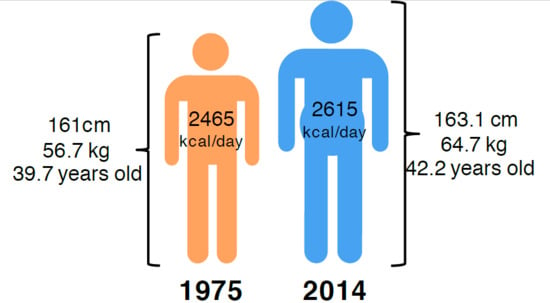Food Security for an Aging and Heavier Population
Abstract
:1. Introduction
“To compute per capita dietary energy consumption in calories, the FAO has traditionally relied on food balance sheets… this choice was due mainly to the lack of suitable surveys conducted regularly.”.(p. 49, [20])
“The (food consumption) values are assessed through a commodity balance model and include household level and retail wastes. They are, therefore, not equal to actual food intake but are commonly used and well suited for cross-country comparisons…”.(p. 4, [12])
“Although these [dietary] data include wastes from processing, packaging, and transport, they do not include consumer waste and so do not correspond to the average consumed diet.”.(p. 13415, [27])
2. Materials and Methods
2.1. Food Energy Demand Calculations
2.2. Data Sources
3. Results
3.1. Global Trends
3.2. National Trends
4. Discussion
Limitations and Strengths
5. Policy Implications
6. Conclusions
Supplementary Materials
Author Contributions
Funding
Acknowledgments
Conflicts of Interest
References
- Meadows, D.H.; Goldsmith, E.; Meadow, P. The Limits to Growth; Universe Books: New York, NY, USA, 1972; Volume 381. [Google Scholar]
- Malthus, T.R. An Essay on the Principle of Population as It Affects the Future Improvement of Society, with Remarks on the Speculations of Mr. Goodwin, M. Condorcet and Other Writers, 1st ed.; J. Johnson: London, UK, 1798. [Google Scholar]
- Lewis, S.L.; Maslin, M.A. Defining the Anthropocene. Nature 2015, 519, 171–180. [Google Scholar] [CrossRef] [PubMed]
- Foley, J. Living by the lessons of the planet. Science 2017, 356. [Google Scholar] [CrossRef] [PubMed]
- Ivanova, D.; Vita, G.; Steen-Olsen, K.; Stadler, K.; Melo, P.C.P.C.; Wood, R.; Hertwich, E.G. Mapping the carbon footprint of EU regions. Environ. Res. Lett. 2017, 12, 054013. [Google Scholar] [CrossRef] [Green Version]
- Fischer-Kowalski, M.; Krausmann, F.; Pallua, I. A sociometabolic reading of the Anthropocene: Modes of subsistence, population size and human impact on Earth. Anthr. Rev. 2014, 20, 1–26. [Google Scholar] [CrossRef]
- Fischer-Kowalski, M.; Swilling, M.; von Weizsäcker, E.U.; Ren, Y.; Moriguchi, Y.; Crane, W.; Krausmann, F.; Eisenmenger, N.; Giljum, S.; Hennicke, P.; et al. UNEP (2011) Decoupling Natural Resource Use and Environmental Impacts from Economic Growth: A Report of the Working Group on Decoupling to the International Resource Panel; United Nations Environment Programme: Nairobi, Kenya, 2011. [Google Scholar]
- Chertow, M.R. The IPAT Equation and Its Variants. J. Ind. Ecol. 2000, 4, 13–29. [Google Scholar] [CrossRef]
- Dietz, T.; Rosa, E.A. Effects of population and affluence on CO2 emissions. Proc. Natl. Acad. Sci. USA 1997, 94, 175–179. [Google Scholar] [CrossRef] [PubMed]
- Blanco, G.; Gerlagh, R.; Suh, S.; Barrett, J.; de Coninck, H.C.; Diaz Morejon, C.F.; Mathur, R.; Nakicenovic, N.; Ofosu Ahenkora, A.; Pan, J.; et al. Drivers, Trends and Mitigation. In Climate Change 2014. Mitigation of Climate Change. Working Group III Contribution to the Fifth Assessment Report of the Intergovernmental Panel on Climate Change; Cambridge University Press: New York, NY, USA, 2014; pp. 351–412. [Google Scholar]
- Crist, E.; Mora, C.; Engelman, R. The interaction of human population, food production, and biodiversity protection. Science 2017, 356, 260–264. [Google Scholar] [CrossRef] [PubMed]
- Kastner, T.; Rivas, M.J.I.; Koch, W.; Nonhebel, S. Global changes in diets and the consequences for land requirements for food. Proc. Natl. Acad. Sci. USA 2012, 109, 6868–6872. [Google Scholar] [CrossRef] [PubMed] [Green Version]
- Zijdeman, R.; Ribeira da Silva, F. Life Expectancy at Birth (Total)—Clio-Infra Dataverse. Available online: https://www.clio-infra.eu/Indicators/LifeExpectancyatBirthTotal.html# (accessed on 24 September 2018).
- NCD Risk Factor Collaboration (NCD-RisC). A century of trends in adult human height. Elife 2016, 5, 1–29. [Google Scholar] [CrossRef]
- Finucane, M.M.; Stevens, G.A.; Cowan, M.J.; Danaei, G.; Lin, J.K.; Paciorek, C.J.; Singh, G.M.; Gutierrez, H.R.; Lu, Y.; Bahalim, A.N.; et al. National, regional, and global trends in body-mass index since 1980: Systematic analysis of health examination surveys and epidemiological studies with 960 country-years and 9·1 million participants. Lancet 2011, 377, 557–567. [Google Scholar] [CrossRef]
- NCD Risk Factor Collaboration. Trends in adult body-mass index in 200 countries from 1975 to 2014: A pooled analysis of 1698 population-based measurement studies with 192 million participants. Lancet 2016, 387, 1377–1396. [Google Scholar] [CrossRef]
- Vaupel, J.W. Biodemography of human ageing. Nature 2010, 464, 536–542. [Google Scholar] [CrossRef] [PubMed] [Green Version]
- Lutz, W.; Butz, W.P.; Samir, K.C. World Population and Human Capital in the Twenty-First Century; Oxford University Press: Oxford, UK, 2014; ISBN 0191008222. [Google Scholar]
- Lee, R.D.; Mason, A. Population Aging and the Generational Economy: A Global Perspective; Edward Elgar Publishing: Cheltenham, UK, 2011; ISBN 978-1-84844-898-8. [Google Scholar]
- FAO; IFAD; WFP. The State of Food Insecurity in the World: Meeting the 2015 International Hunger Targets: Taking Stock of Uneven Progress; Food and Agriculture Organiztaion of the United Nations: Rome, Italy, 2015; ISBN 978-92-5-108785-5. Available online: www.fao.org/3/a-i4646e.pdf (accessed on 3 October 2018).
- UN General Assembly. Transforming Our World: The 2030 Agenda for Sustainable Development; United Nations: New York, NY, USA, 2015; pp. 1–35. [Google Scholar]
- Tilman, D.; Balzer, C.; Hill, J.; Befort, B. Global food demand and the sustainable intensification of agriculture. Proc. Natl. Acad. Sci. USA 2011, 108, 20260–20264. [Google Scholar] [CrossRef] [PubMed] [Green Version]
- Gustavvson, J.; Cederberg, C.; Sonesson, U.; Van Otterdijk, R.; Meybeck, A. Global Food Losses and Food Waste—Extent, Causes and Prevention; FAO: Rome, Italy, 2011. [Google Scholar]
- Rayfuse, R.; Weisfelt, N. The Challenge of Food Security; Edward Elgar Publishing: Cheltenham, UK, 2012; Volume 327, ISBN 9780857939388. [Google Scholar]
- Shafiee-Jood, M.; Cai, X. Reducing Food Loss and Waste to Enhance Food Security and Environmental Sustainability. Environ. Sci. Technol. 2016, 50, 8432–8443. [Google Scholar] [CrossRef] [PubMed]
- Xue, L.; Liu, G.; Parfitt, J.; Liu, X.; Van Herpen, E.; Stenmarck, A.; O’Connor, C.; Östergren, K.; Cheng, S. Missing food, missing data? A critical review of global food losses and food waste data. Environ. Sci. Technol. 2017, 51, 6618–6633. [Google Scholar] [CrossRef] [PubMed]
- Behrens, P.; Kiefte-de Jong, J.C.; Bosker, T.; Rodrigues, J.F.D.; de Koning, A.; Tukker, A. Evaluating the environmental impacts of dietary recommendations. Proc. Natl. Acad. Sci. USA 2017, 114, 201711889. [Google Scholar] [CrossRef] [PubMed]
- Food and Agriculture Organization of the United Nations ESS Website ESS: Food Balance Sheets. Available online: http://www.fao.org/economic/ess/fbs/en/ (accessed on 2 October 2018).
- Hiç, C.; Pradhan, P.; Rybski, D.; Kropp, J.P. Food Surplus and Its Climate Burdens. Environ. Sci. Technol. 2016, 50, 4269–4277. [Google Scholar] [CrossRef] [PubMed]
- Rao, N.D.; Baer, P. “Decent Living” emissions: A conceptual framework. Sustainability 2012, 4, 656–681. [Google Scholar] [CrossRef] [Green Version]
- FAO; IFAD; UNICEF; WFP; WHO. The State of Food Security and Nutrition in the World; FAO: Rome, Italy, 2017; ISBN 978-92-5-109888-2. [Google Scholar]
- Alexandratos, N.; Bruinsma, J. World agriculture: Towards 2015/2030: An FAO perspective. Land Use Policy 2003, 20, 375. [Google Scholar] [CrossRef]
- O’Neill, D.W.; Fanning, A.L.; Lamb, W.F.; Steinberger, J.K. A good life for all within planetary boundaries. Nat. Sustain. 2018, 1, 88–95. [Google Scholar] [CrossRef]
- FAO. Human Energy Requirements: Report of a Joint FAO/WHO/UNU Expert Consultation; FAO: Rome, Italy, 2001; Volume 1. [Google Scholar]
- Heymsfield, S.B.; Bourgeois, B.; Thomas, D.M. Assessment of human energy exchange: Historical overview. Eur. J. Clin. Nutr. 2016, 1–7. [Google Scholar] [CrossRef] [PubMed]
- Müller, M.J.; Geisler, C. From the past to future: From energy expenditure to energy intake to energy expenditure. Eur. J. Clin. Nutr. 2016, 1–7. [Google Scholar] [CrossRef]
- Westerterp, K.R. Control of energy expenditure in humans. Eur. J. Clin. Nutr. 2016, 1–5. [Google Scholar] [CrossRef] [PubMed]
- Hall, K.D.; Guo, J.; Dore, M.; Chow, C.C. The progressive increase of food waste in America and its environmental impact. PLoS ONE 2009, 4, e7940. [Google Scholar] [CrossRef] [PubMed]
- Walpole, S.C.; Prieto-Merino, D.; Edwards, P.; Cleland, J.; Stevens, G.; Roberts, I. The weight of nations: An estimation of adult human biomass. BMC Public Health 2012, 12, 439. [Google Scholar] [CrossRef] [PubMed]
- West, P.C.; Gerber, J.S.; Engstrom, P.M.; Mueller, N.D.; Brauman, K.A.; Carlson, K.M.; Cassidy, E.S.; Johnston, M.; MacDonald, G.K.; Ray, D.K.; et al. Leverage points for improving global food security and the environment. Science 2014, 345, 325–328. [Google Scholar] [CrossRef] [PubMed] [Green Version]
- Porter, J.R.; Xie, L.; Challinor, A.J.; Cochrane, K.; Howden, S.M.; Iqbal, M.M.; Lobell, D.B.; Travasso, M.I. Food security and food production systems. In Climate Change 2014: Impacts, Adaptation, and Vulnerability. Part A: Global and Sectoral Aspects; Cambridge University Press: New York, NY, USA, 2014. [Google Scholar]
- Valin, H.; Sands, R.D.; van der Mensbrugghe, D.; Nelson, G.C.; Ahammad, H.; Blanc, E.; Bodirsky, B.; Fujimori, S.; Hasegawa, T.; Havlik, P.; et al. The future of food demand: Understanding differences in global economic models. Agric. Econ. 2014, 45, 51–67. [Google Scholar] [CrossRef]
- Lunenfeld, B. An Aging World—Emographics and challenges. Gynecol. Endocrinol. 2008, 24, 1–3. [Google Scholar] [CrossRef] [PubMed]
- Lutz, W.; Sanderson, W.C.; Scherbov, S. The coming acceleration of global population ageing. Nature 2008, 451, 716–719. [Google Scholar] [CrossRef] [PubMed]
- Lutz, W. Demographic Metabolism: A Predictive Theory of Socioeconomic Change. Popul. Dev. Rev. 2012, 38, 283–301. [Google Scholar] [CrossRef] [Green Version]
- Vásquez, F.; Løvik, A.N.; Sandberg, N.H.; Müller, D.B. Dynamic type-cohort-time approach for the analysis of energy reductions strategies in the building stock. Energy Build. 2016, 111, 37–55. [Google Scholar] [CrossRef]
- Müller, D.B. Stock dynamics for forecasting material flows—Case study for housing in The Netherlands. Ecol. Econ. 2006, 59, 142–156. [Google Scholar] [CrossRef]
- Olaya, Y.; Vásquez, F.; Müller, D.B. Dwelling stock dynamics for addressing housing deficit. Resour. Conserv. Recycl. 2017, 123, 187–199. [Google Scholar] [CrossRef]
- Department of Economic and Social Affairs, United Nations. Population Division World Population Prospects: The 2015 Revision, DVD Edition. Available online: http://esa.un.org/unpd/wpp/Download/Standard/Population/ (accessed on 7 April 2016).
- Deaton, A. Height, health, and development. Proc. Natl. Acad. Sci. USA 2007, 104, 13232–13237. [Google Scholar] [CrossRef] [PubMed] [Green Version]
- Dubois, L.; Ohm Kyvik, K.; Girard, M.; Tatone-Tokuda, F.; Pérusse, D.; Hjelmborg, J.; Skytthe, A.; Rasmussen, F.; Wright, M.J.; Lichtenstein, P.; et al. Genetic and environmental contributions to weight, height, and bmi from birth to 19 years of age: An international study of over 12,000 twin pairs. PLoS ONE 2012, 7, e30153. [Google Scholar] [CrossRef] [PubMed]
- Rao, N.D.; Min, J.; Defries, R.; Ghosh-jerath, S.; Valin, H.; Fanzo, J. Healthy, affordable and climate-friendly diets in India. Glob. Environ. Chang. 2018, 49, 154–165. [Google Scholar] [CrossRef]
- Ivanova, D.; Vita, G.; Wood, R.; Lausselet, C.; Dumitru, A.; Krause, K.; Macsinga, I.; Hertwich, E.G. Carbon mitigation in domains of high consumer lock-in. Glob. Environ. Chang. 2018, 52, 117–130. [Google Scholar] [CrossRef]
- Vita, G.; Hertwich, E.G.; Stadler, K.; Wood, R. Connecting global emissions to fundamental human needs and their satisfaction. Environ. Res. Lett. 2018. [Google Scholar] [CrossRef]
- Rao, N.D.; Min, J. Decent Living Standards: Material prerequisites for human wellbeing. Soc. Indic. Res. 2018, 138, 225–244. [Google Scholar] [CrossRef] [PubMed]
- Gould, J. Nutrition: A world of insecurity. Nature 2017, 544, S6–S7. [Google Scholar] [CrossRef] [PubMed]
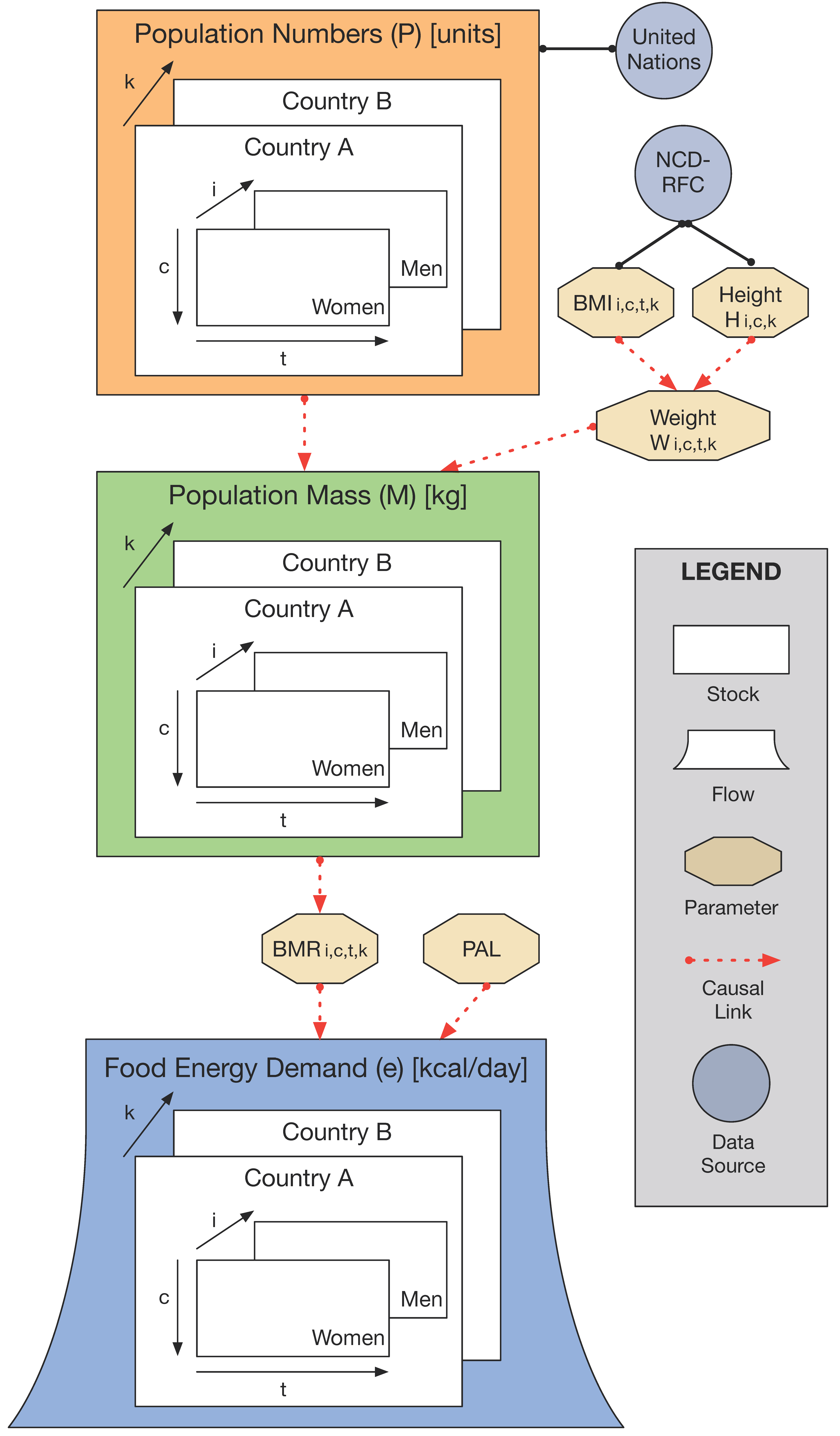
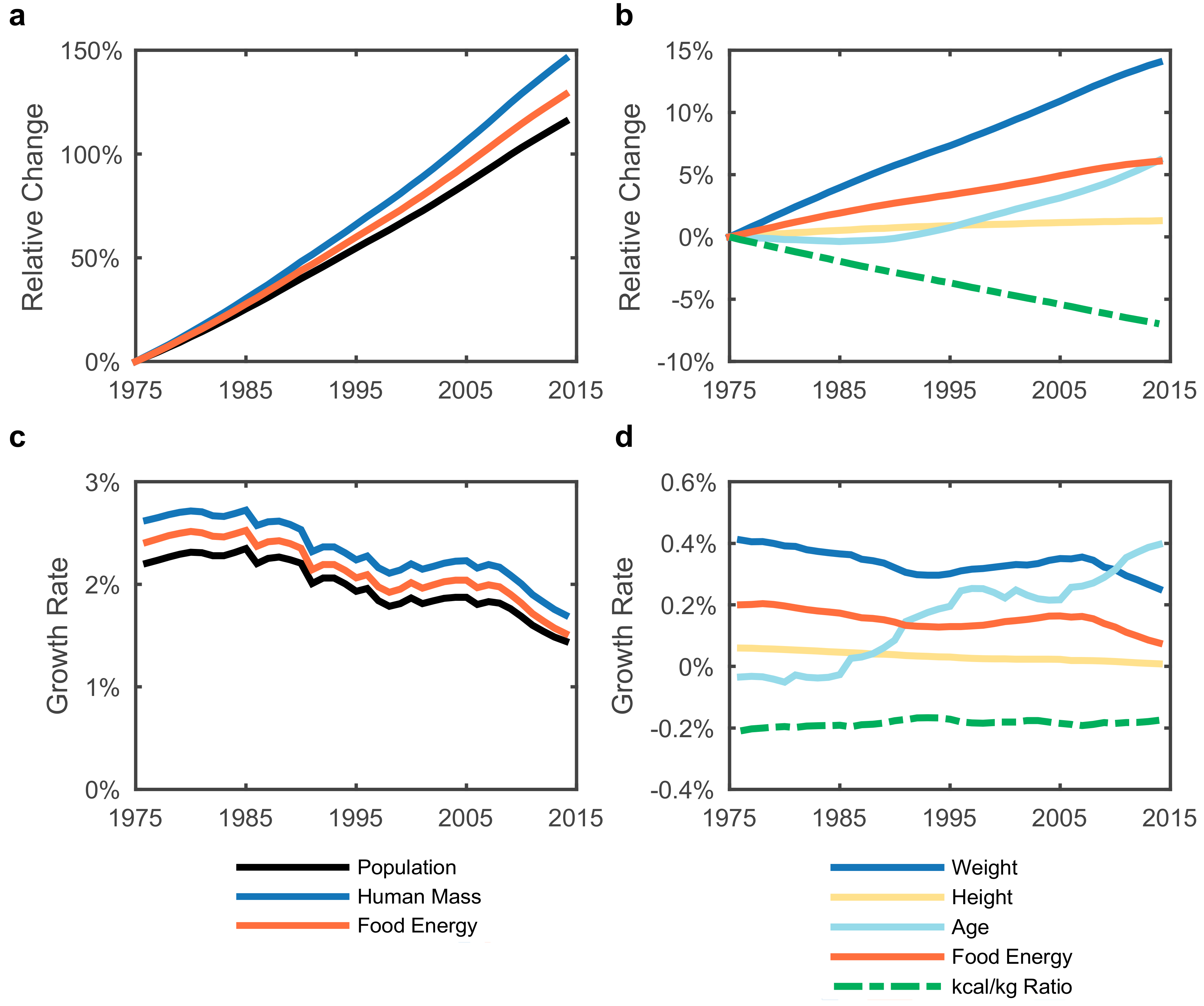
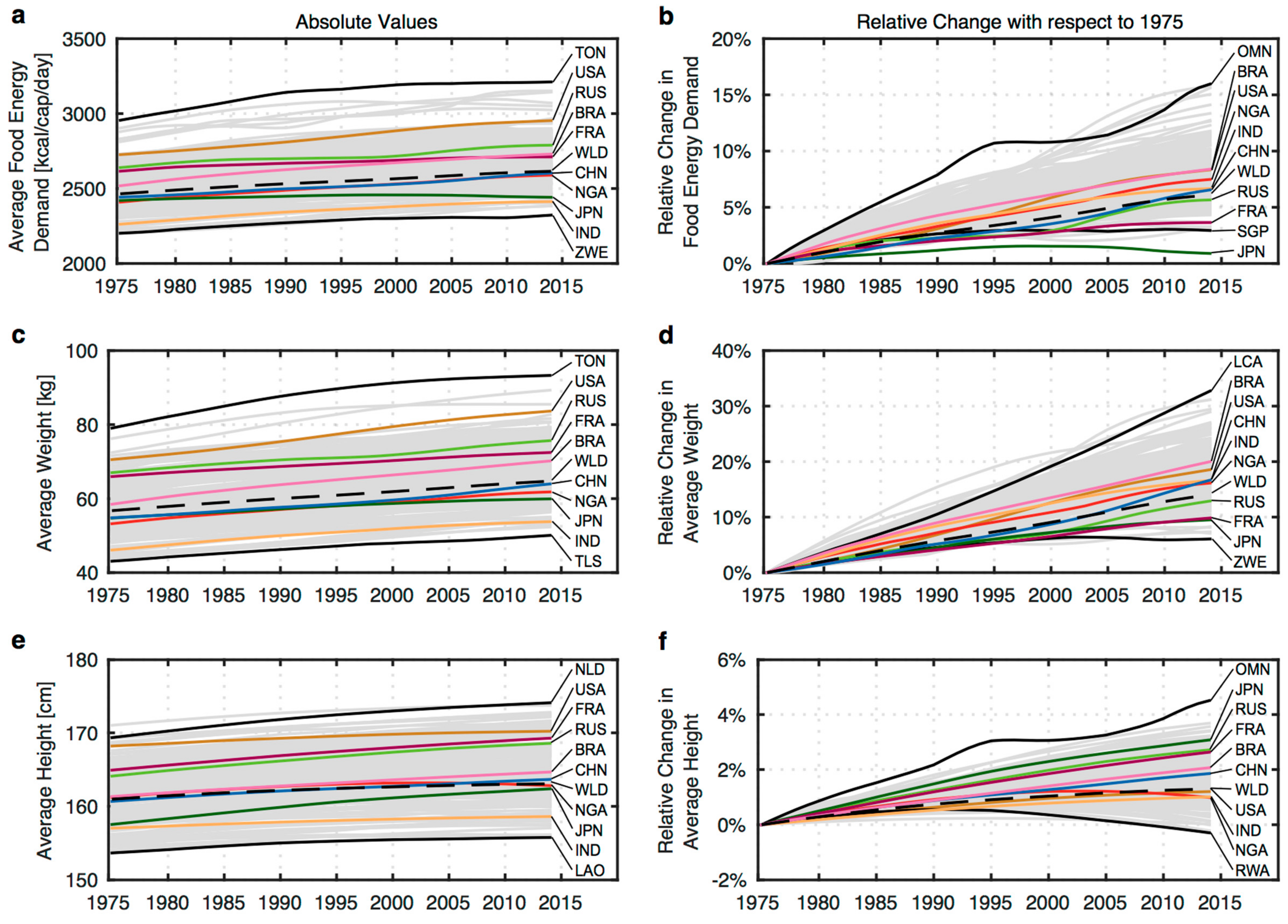
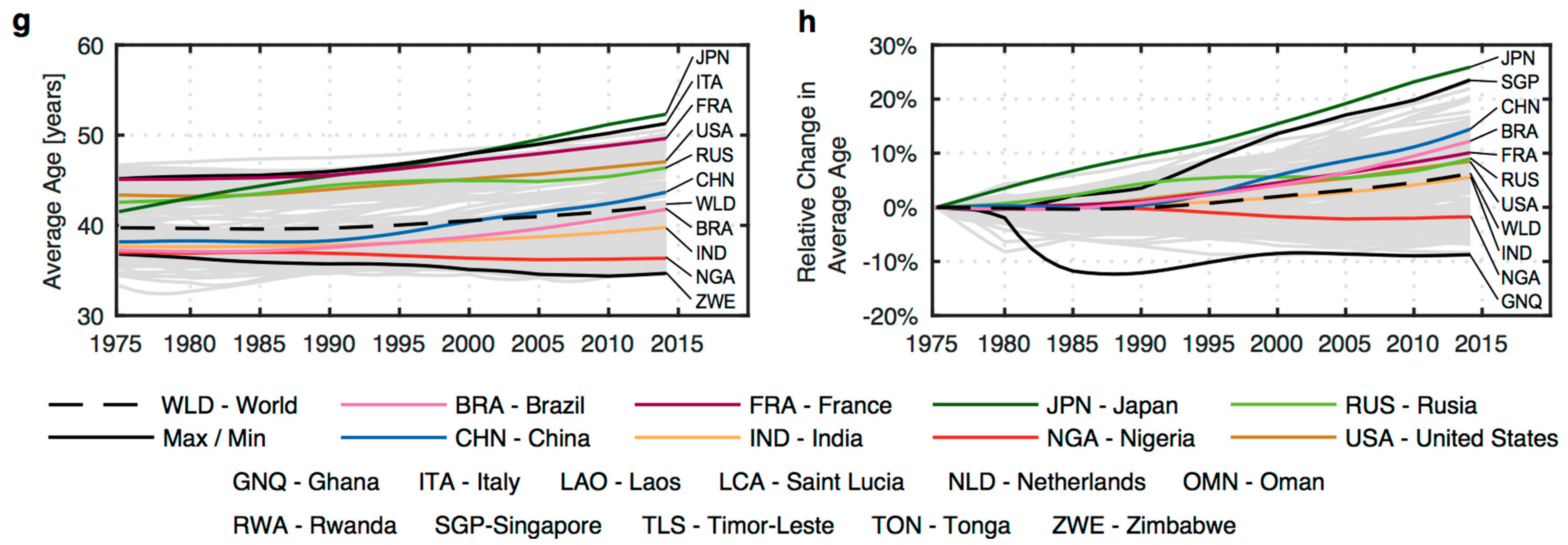

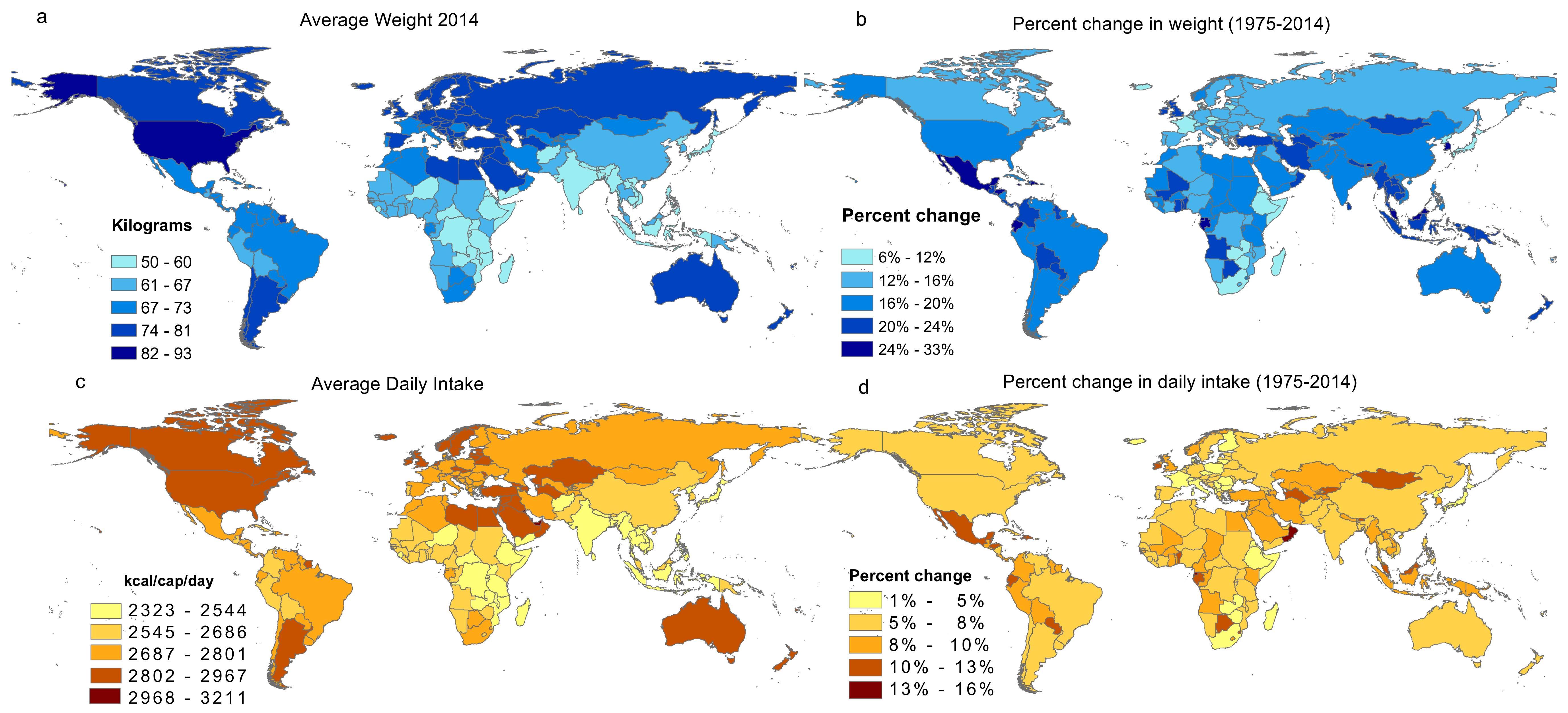
| Average Food Energy Demand [kcal/Cap/Day] | Rel. Change in Food Energy | Average Weight [kg] | Rel. Change in Weight | ||||||||
|---|---|---|---|---|---|---|---|---|---|---|---|
| 1975 | 2014 | ▲1975–2014 | 1975 | 2014 | ▲1975–2014 | ||||||
| Highest 10 | |||||||||||
| TON | 2955.8 | TON | 3211.4 | OMN | 16.0% | TON | 79.1 | TON | 93.3 | LCA | 32.7% |
| PYF | 2903.5 | QAT | 3151.3 | GNQ | 15.7% | PYF | 76.2 | WSM | 89.3 | GNQ | 31.1% |
| ARE | 2879.4 | WSM | 3143.6 | LCA | 15.6% | WSM | 72.5 | PYF | 85.5 | CPV | 29.4% |
| QAT | 2831.3 | ARE | 3070.9 | CPV | 15.0% | CZE | 71.6 | USA | 83.6 | MDV | 28.9% |
| KWT | 2830.9 | PYF | 3050.7 | GRD | 14.1% | KWT | 70.7 | LCA | 82.7 | MYS | 27.0% |
| WSM | 2812.4 | KWT | 3024.4 | VCT | 13.4% | USA | 70.6 | QAT | 81.6 | GRD | 26.8% |
| ISL | 2730.7 | LCA | 2966.8 | JAM | 12.7% | ISL | 70.1 | KWT | 80.8 | KOR | 26.7% |
| CZE | 2726.8 | USA | 2953.4 | GAB | 12.6% | LTU | 69.6 | NZL | 80.6 | JAM | 26.3% |
| USA | 2726.3 | PSE | 2949.1 | KGZ | 12.3% | ARE | 68.9 | AUS | 79.3 | VCT | 26.2% |
| FSM | 2707.3 | JOR | 2941.0 | WSM | 11.8% | EST | 68.8 | IRL | 79.2 | HND | 26.0% |
| Lowest 10 | |||||||||||
| IND | 2262.2 | JPN | 2441.8 | CZE | 4.4% | BDI | 46.8 | ERI | 54.9 | SGP | 10.6% |
| BDI | 2261.5 | LAO | 2430.0 | MKD | 4.3% | MMR | 46.5 | NPL | 54.8 | SOM | 10.3% |
| MMR | 2259.3 | KHM | 2420.7 | MDG | 3.7% | IND | 46.1 | LAO | 54.6 | CZE | 10.1% |
| IDN | 2243.8 | ETH | 2414.8 | FRA | 3.6% | IDN | 45.5 | KHM | 54.4 | FRA | 9.8% |
| KHM | 2230.7 | NPL | 2414.1 | ZWE | 3.3% | LAO | 44.9 | ETH | 53.9 | JPN | 9.5% |
| LAO | 2229.8 | IND | 2412.8 | HKG | 3.3% | KHM | 44.8 | IND | 53.8 | PRK | 8.3% |
| NPL | 2223.1 | MDG | 2402.7 | DJI | 3.2% | NPL | 44.3 | MDG | 53.1 | MDG | 8.1% |
| BGD | 2219.6 | VNM | 2384.4 | PRK | 3.2% | VNM | 44.1 | VNM | 52.8 | DJI | 7.4% |
| TLS | 2202.0 | BGD | 2384.1 | SGP | 2.9% | BGD | 43.8 | BGD | 52.3 | BHR | 7.1% |
| VNM | 2199.1 | TLS | 2322.7 | JPN | 0.9% | TLS | 43.1 | TLS | 50.1 | ZWE | 6.1% |
© 2018 by the authors. Licensee MDPI, Basel, Switzerland. This article is an open access article distributed under the terms and conditions of the Creative Commons Attribution (CC BY) license (http://creativecommons.org/licenses/by/4.0/).
Share and Cite
Vásquez, F.; Vita, G.; Müller, D.B. Food Security for an Aging and Heavier Population. Sustainability 2018, 10, 3683. https://doi.org/10.3390/su10103683
Vásquez F, Vita G, Müller DB. Food Security for an Aging and Heavier Population. Sustainability. 2018; 10(10):3683. https://doi.org/10.3390/su10103683
Chicago/Turabian StyleVásquez, Felipe, Gibran Vita, and Daniel B. Müller. 2018. "Food Security for an Aging and Heavier Population" Sustainability 10, no. 10: 3683. https://doi.org/10.3390/su10103683
APA StyleVásquez, F., Vita, G., & Müller, D. B. (2018). Food Security for an Aging and Heavier Population. Sustainability, 10(10), 3683. https://doi.org/10.3390/su10103683




